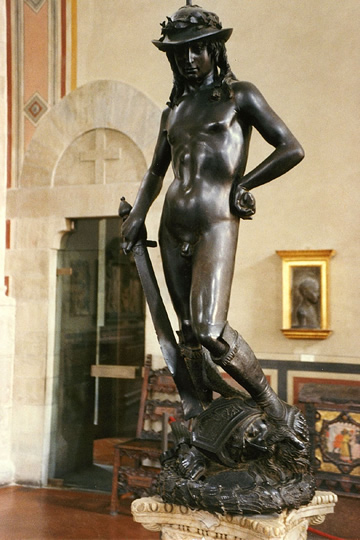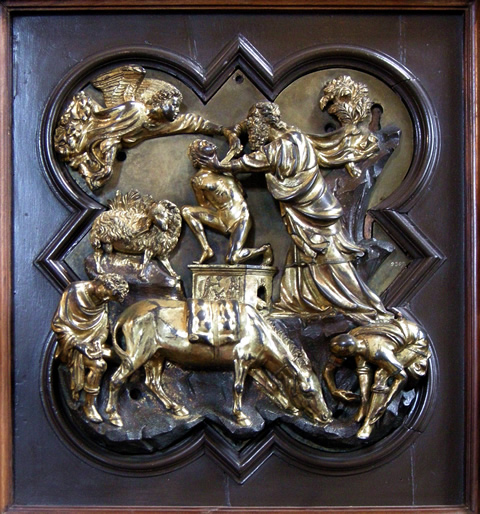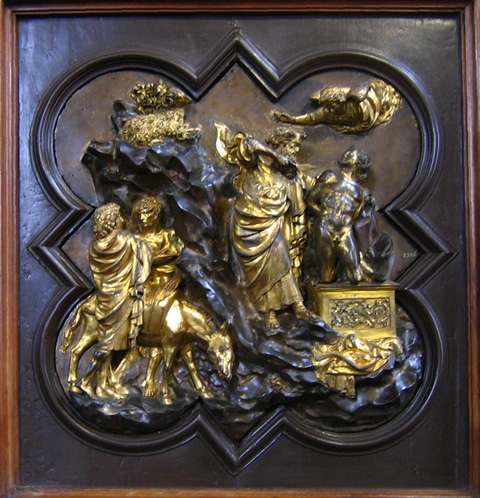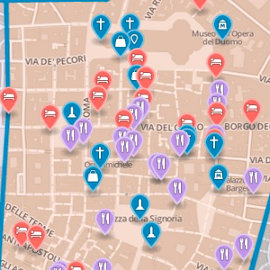
Palazzo del Bargello. (Photo by magro_kr)
What the Uffizi is to painting, the Bargello is to Renaissance sculpture—largely because this actually was the Uffizi's sculpture and applied arts collection, moved here in 1859 after it outgrew the Uffizi space.
This imposing, castle-like palazzo was built in 1255–1350 as the original "Palazzo del Popolo" seat of government. It remained the mayor's office until 1502, when it became a police headquarters and prison until 1859 (see below).
It now contains the greatest collection of Renaissance sculpture in Florence—in fact, one of the best in all of Italy.
You could spend 45 minutes or two hours here, depending how much you're into the early works of Michelangelo (a wonderfully tipsy Bacchus, the Madonna of the Stairs, and a Bust of Brutus that may be a semi self-portrait), Donatello (the Bargello contains some of the gretest masterpieces by thus first truly great sculptor of the Renaissance), and mannerist Giambologna (his Flying Mercury and many whimsical animal bronzes intended to decorate Medici gardens).
These reside in the Bargello alongside statues by Brunelleschi, Desiderio da Settignano, Agostino di Duccio, Vecchietta, and Michelozzo, glazed terracottas by the della Robbia clan, and collections of fine porcelain, objets d'art, silverwork, and other decorative arts,
The Bargello even contains the Baptistry doors competition piece by Lorenzo Ghiberti that is considered, by many art historians, to have officially started the Renaissance period.
Downstairs in the Bargello—Michelangelo and the High Renaissance
In the palazzo's old armory are 16th-century works, including some of Michelangelo's earliest sculptures.
Carved by a 22-year-old Michelangelo while he was visiting Rome, Bacchus ★★ (1497) was obviously inspired by the classical antiquities he studied there but is also imbued with his own irrepressible Renaissance realism—here is a (young) God of Wine who's actually drunk, reeling back on unsteady knees and holding the cup aloft with a distinctly tipsy wobble.
Michelangelo polished and finished this marble in the traditional manner, but from 1503 to 1505, soon after finishing his famous David with a high polish, he carved the Pitti Tondo ★ here, a schiacciato Madonna and Child scene in which the artist began using the textures of the partially worked marble itself to convey his artistic message.
One of Michelangelo's weaker works here is the so-called Apollo-David (art historians can't agree on which hero the unfinished work was meant to be), but the master is back in top form with the bust of Brutus(ca. 1539). Some people like to see in this sculpture an idealized portrait of Michelangelo himself; a more accurate and less contentious representation sits nearby, the famous and oft-cast bronze bust of Michelangelo by his pupil Daniele da Volterra.
Also in this room is Giambologna's Flying Mercury ★ (ca. 1564), looking for all the world as if he's on the verge of taking off from the ground—justifiably one of this mannerist's masterpieces.
The Bargello courtyrad
The baddest prison in town
After a confession had been rung out of them by the authorities inside, the bodies of particularly reviled criminals were hung from the Bargello's windows.
The great artists of the day would be commissioned to come paint the portraits of the malefactors on the lower external walls as a warning to others.
When Grand Duke Pietro Leopoldo abolished the death penalty in 1786, the Bargello's torture instruments were ceremoniously burned in the Bargello's über-medieval courtyard.
The palazzo's inner courtyard—one of the few medieval cortile in Florence to survive in more-or-less its original shape—is studded with the coats of arms of various past podestà and other notables.
The grand stairwell leads up to a second-story loggia filled with a flock of whimsical bronze birds cast by Giambologna for the Medici's gardens.
A room full of Donatellos

Donatello's bronze David in the Bargello Museum. (Photo by Patrick A. Rodgers)
The doorway leads into the old Salone del Consiglio Generale (General Council Room) ★★, a vast space with a high ceiling filled with glazed terra-cotta Madonnas by Luca della Robbia and his clan, and some of the most important sculptures of the early Renaissance.
Donatello dominates the room, starting with a mischievously smiling Atys-Amorino cupid (ca. 1430–40).
Nearby is Donatello's polychrome bust of Niccolò da Uzzano, a bit of hyperrealism next to two much more delicate busts of elfin-featured characters by Desiderio da Settignano.
Donatello sculpted this most oft-copied version of the Marzocco, lion symbol of the Florentine Republic, out of pietra serena between 1418 and 1420.
The marble David (1408) is an early Donatello, but the bronze David ★★ (1440–50) beyond it is a much more mature piece. The Biblical hero here is a nubile, almost erotic youth, naked save for his helmet and massive sword, with a shy, detached air that has little to do with the foot resting casually atop the head of the slain Goliath. It was considered even at the time to be one of the greatest masterpieces of early Renaissance sculpture—and was the first free-standing bronze nude cast since antiquity
Against the far wall is Donatello's St. George ★, carved in 1416 for a niche of Orsanmichele. Look at the masterful panel beneath showing the saint slaying his dragon done in an early example of the sculptor's patented schiacciato, a technique of working in extreme low relief, using thinly etched lines often barely scratched into the marble and perspective (a good decade before the use of linear perspective in painting) to create great depth in a very shallow space.
The room has more than just the Donatellos. There are stellar sculptures by Desiderio da Settignano, Agostino di Duccio, Vecchietta, and Michelozzo, as well as some of the the patented glazed terracottas of Luca della Robbia and Andrea della Robbia.
I also like to point out a small work on the wall, a tumultuous Battle Scene by one of Donatello's star students, Giovanni di Bertoldo. Bertoldo would later go on to teach a talented teenager named Michelangelo how to sculpt. (Look at the similar work by a young Michelangelo in the Casa Buonarotti and you'll see Bertoldo's influence.)
In the back right corner of this room are two bronze relief panels by Brunelleschi and Ghiberti of the Sacrifice of Isaac, finalists in the famous 1401 competition for the commission to cast the Baptistery's doors. Ghiberti's panel won for the greater dynamism and flowing action in his version. This proved to be a turning point in art—the start of the Renaissance (see below).
The very first work of Renaissance art


Two takes on the Sacrifice of Isaac for the 1401 Baptistery doors competition. Above, Brunelleschi's runner-up entry; below, Ghiberti's winning entry. Modestly in a corer on the wall of this cavernous space are the two finalist bronze panels of Abraham Sacrificing Isaac that, in many scholars' estimations, marked the beginning of the Renaissance. Why more guidebooks don't make a big deal out of this is beyond me.
These panels were submissions to a 1401 contest held by the powerful Arte di Calimala (Wool Guild) to pick an artist to cast images for the new North Doors of the baptistery. All the great Gothic sculptors of the day entered the contest, including Donatello, Brunelleschi, and Jacopo della Quercia.
The judges surprised everyone by picking a relatively obscure 23-year-old sculptor named Lorenzo Ghiberti. At first glance, these panels from both finalists—Ghiberti and Brunelleschi—are very similar in composition. Look more closely, though, and you'll see why Ghiberti's won.
Brunelleschi's figures look posed and still. Ghiberti's look as if we're seeing a snapshot of action, frozen in the moment.
Brunelleschi's figures are stylized. Ghiberti's are naturalistic.
Brunelleschi's figures are simply laid out in a tableau, with the main action dead center. Ghiberti's are composed to tell a story and, along with the shape and flow of the background rock, move the action dramatically around the scene, drawing your attention to the sacrifice happening on extreme stage right (offsetting it like this adds to the tension of the moment).
Brunelleschi's posed figures are seen mostly from straight on (a bent-over shepherd notwithstanding). Ghiberti uses perspective to make his angel leap toward the audience from the clouds, and stacks the shepherds on either side of the donkey both to look more natural and to help sell the illusion of depth.
In short, Brunelleschi submitted a gorgeous and masterful work of Gothic art. Ghiberti, however, submitted something new, something that made use of the most current advances and cutting-edge thinking in art.
Something worthy of being called "Renaissance."
The rest of the Bargello
Out the other end of the vast Donatello room is the Islamic Collection, a testament to Florence's wide and profitable trade network.
Decorative arts from the Roman era through the 16th century fill the long corridor, at the end of which is the small Cappella Maddalena, where condemned prisoners spent their last moments praying for their souls; it was frescoed by Giotto's studio. A perpendicular corridor houses the largest collection of ivories in the world, from the 5th to 17th centuries.
Upstairs are rooms with glazed terra cottas by Andrea and Giovanni della Robbia and another room devoted to the sculptural production of Leonardo da Vinci's teacher Verrocchio, including yet another David (1465), a haughty youth with a tousle of hair inspired by the Donatello version downstairs.



